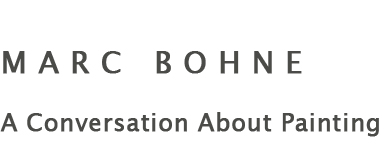Going to expand a bit on drawing, to add to the first post.
Talking about line, in a non-traditional sense, means really
understanding it for what it is. For something with no real mass it has a lot
of weight.
When I was talking about line formed by the meeting of
values, it can be an actual line, or
an inferred line. Where values or
hues come together they both signal a change, and also move our eye. Where
value or hue are blended in that meeting, the line is still there, just inferred
now. The line always defines the shape, even if you cant see it.
If you paint a tree in a field, and it is surrounded by sky,
you can see the tree as positive space, and the sky as negative. Where those
two meet is the drawing.
When I do a painting, I generally do a dynamic drawing of
the subject. That is, no artificial ways to insure likeness. My eye to panel.
All corrections are done that way as well. It is allowed to be flawed.
The second stage of a painting (in my convoluted technique)
is to do an underpainting with colored gesso. It is really the drawing with a
little color. I recommend drawing with black and white gesso, as it is a great
way to explore line without color complicating things. Using colored gessoes is
sort of an advanced thing. I use water-based gesso, and it dries mad fast so it
is easy to go over with corrections. It
sort of brings painting and drawing together.
I save all my old brushes for this.
This is all still drawing to me.
The other line that is more complicated is the inferred
line. This is the one that you cannot see, but moves your eye around the
picture plane just as well. If your
drawing is done well, it will have inferred line that helps the eye explore,
and brings the conversation into a smooth understanding. It can lead to, or
away, from things that would be easy for the eye to rest on (consonance and
dissonance). This is totally the artist IN the work. (If a batter hits the ball, we follow the trajectory of the ball even if we cant see it.)
Below are some simple examples of what I am trying to say... the crow is a simple line, but there is an inferred line between the head and body, as well as a directive that you finish it in your head.
The second is a small painting with and without the color. In black and white, it is ALL drawing. Lots of examples of what I mean, if not what I said...
There! Have a nice day!




Really fascinating blog Marc. Great to read about
ReplyDeleteyour thoughts on painting...
thanks, chris
DeleteVery informative! It's nice to see these principles (that beginning artists like me struggle with) expressed in words. It helps to get better if you have an actual grasp of what you're trying to accomplish, instead of just "That's pretty! I must paint it". Thank you! Keep it up.
ReplyDeletethis wont always be instructional... hopefully some insights to motive, etc.
DeleteIt is valuable to see the beginning of your technique described so clearly. Thank you
ReplyDelete